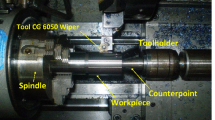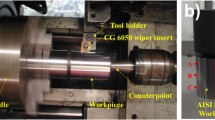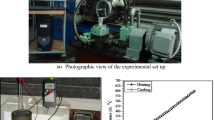Abstract
Hard turning operations have been extensively investigated owing to their ability to reduce process cycle time, increase process flexibility, ensure high-dimensional accuracy, and enable machining without a cutting fluid. These processes are rather common for dealing with multiple quality characteristics. To evaluate the process ability and meet customer needs, multivariate statistical techniques are recommended for estimating the capability indices. Principal component analysis can be applied to reducing the problem dimension and estimate process capability indices. The aim of this study was to assess the capability of AISI 52100 hardened steel turning operations and achieve process specifications. Multivariate process capability indices were calculated to assess five roughness parameters of surface finishing. By using a weighted approach of principal component analysis, a new method is proposed for estimating the process capability indices. The results highlight not only the relevance of conducting a multivariate capability analysis in the case of actual machining but also how successfully the proposed method was performed.
Similar content being viewed by others
References
Paiva AP, Paiva EJ, Ferreira JR, Balestrassi PP, Costa SC (2009) A multivariate mean square error optimization of AISI 52100 hardened steel turning. Int J Adv Manuf Technol 43(7-8):631–643. https://doi.org/10.1007/s00170-008-1745-5
Huang Y, Chou YK, Liang SY (2007) CBN tool wear in hard turning: a survey on research progresses. Int J Adv Manuf Technol 35(5-6):443–453. https://doi.org/10.1007/s00170-006-0737-6
Tamizharasan T, Selvaraj T, Haq AN (2006) Analysis of tool wear and surface finish in hard turning. Int J Adv Manuf Technol 28(7-8):671–679. https://doi.org/10.1007/s00170-004-2411-1
Singh D, Rao PV (2007) A surface roughness prediction model for hard turning process. Int J Adv Manuf Technol 32(11-12):1115–1124. https://doi.org/10.1007/s00170-006-0429-2
Bouacha K, Yallese MA, Mabrouki T, Rigal JF (2010) Statistical analysis of surface roughness and cutting forces using response surface methodology in hard turning of AISI 52100 bearing steel with CBN tool. Int J Refract Met Hard Mater 28(3):349–361. https://doi.org/10.1016/j.ijrmhm.2009.11.011
Saini S, Ahuja IS, Sharma VS (2012) Residual stresses, surface roughness, and tool wear in hard turning: a comprehensive review. Mater Manuf Process 27(6):583–598. https://doi.org/10.1080/10426914.2011.585505
Paiva AP, Campos PH, Ferreira JR, Lopes LGD, Paiva EJ, Balestrassi PP (2012) A multivariate robust parameter design approach for optimization of AISI 52100 hardened steel turning with wiper mixed ceramic tool. Int J Refract Met Hard Mater 30(1):152–163. https://doi.org/10.1016/j.ijrmhm.2011.08.001
Gaitonde VN, Karnik SR, Figueira L, Davim JP (2009) Machinability investigations in hard turning of AISI D2 cold work tool steel with conventional and wiper ceramic inserts. Int J Refract Met Hard Mater 27(4):754–763. https://doi.org/10.1016/j.ijrmhm.2008.12.007
Motorcu AR, Güllü A (2006) Statistical process control in machining, a case study for machine tool capability and process capability. Mater Des 27(5):364–372. https://doi.org/10.1016/j.matdes.2004.11.003
KT Y, Sheu SH, Chen KS (2007) The evaluation of process capability for a machining center. Int J Adv Manuf Technol 33(5-6):505–510. https://doi.org/10.1007/s00170-006-0481-y
Chen J, Zhu F, Li GY, Ma YZ, Tu YL (2012) Capability index of a complex-product machining process. Int J Prod Res 50(12):3382–3394. https://doi.org/10.1080/00207543.2011.578165
Kahraman F, Esme U, Kulekci MK, Kazancoglu Y (2012) Process capability analysis in machining for quality improvement in turning operations. Mater Test 54(2):120–125. https://doi.org/10.3139/120.110306
Pan JN, Li CI (2014) New capability indices for measuring the performance of a multidimensional machining process. Expert Syst Appl 41(5):2409–2414. https://doi.org/10.1016/j.eswa.2013.09.039
CW W, Pearn WL, Kotz S (2009) An overview of theory and practice on process capability indices for quality assurance. Int J Prod Econ 117(2):338–359. https://doi.org/10.1016/j.ijpe.2008.11.008
Montgomery DC (2009) Introduction to statistical quality control, 6th edn. John Wiley & Sons, Hoboken
Pearn WL, Kotz S (2006) Encyclopedia and handbook of process capability indices - a comprehensive exposition of quality control measures. https://doi.org/10.1142/9789812773753
Peruchi RS, Paiva AP, Balestrassi PP, Ferreira JR, Sawhney R (2014) Weighted approach for multivariate analysis of variance in measurement system analysis. Precis Eng 38(3):651–658. https://doi.org/10.1016/j.precisioneng.2014.03.001
Veiga P, Mendes L, Lourenço L (2015) A retrospective view of statistical quality control research and identification of emerging trends: a bibliometric analysis. Qual Quant 50(2):673–692. https://doi.org/10.1007/s11135-015-0170-8
Wang FK, Chen JC (1998) Capability index using principal components analysis. Capability Index Using Principal Components Qual Eng 11(1):37–41. https://doi.org/10.1080/08982119808919208
Wang FK (2006) Quality evaluation of a manufactured product with multiple characteristics. Qual Reliab Eng Int 22(2):225–236. https://doi.org/10.1002/qre.712
Dharmasena LS, Zeephongsekul P (2015) A new process capability index for multiple quality characteristics based on principal components. Int J Prod Res 7543(15):1–17. https://doi.org/10.1080/00207543.2015.1091520
Pearn WL, Wang FK, Yen CH (2007) Multivariate capability indices: distributional and inferential properties. J Appl Stat 34(8):941–962. https://doi.org/10.1080/02664760701590475
Guevara RD, Vargas JA (2015) Evaluation of process capability in multivariate simple linear profiles. J Stat Comput Simul 19(6):1–18. https://doi.org/10.1016/j.scient.2012.09.010
Wang FK (2010) A general procedure for process yield with multiple characteristics. IEEE Trans Semicond Manuf 23(4):503–508. https://doi.org/10.1109/TSM.2010.2057264
Wang FK (2012) Estimating the process yield of multiple characteristics with one-sided specifications. IEEE Trans Semicond Manuf 25(1):57–62. https://doi.org/10.1109/TSM.2011.2169093
Santos-Fernández E, Scagliarini M (2012) MPCI: an R package for computing multivariate process capability indices. J Stat Softw 47(2):1–15. https://doi.org/10.1359/JBMR.0301229
Haridy S, Wu Z, Castagliola P (2011) Univariate and multivariate approaches for evaluating the capability of dynamic-behavior processes (case study). Stat Methodol 8(2):185–203. https://doi.org/10.1016/j.stamet.2010.09.003
Scagliarini M (2011) Multivariate process capability using principal component analysis in the presence of measurement errors. AStA Adv Stat Anal 95(2):113–128. https://doi.org/10.1007/s10182-011-0156-3
Wang FK, TCT D (2000) Using principal component analysis in process performance for multivariate data. Omega 28(2):185–194. https://doi.org/10.1016/S0305-0483(99)00036-5
Tano I, Vannman K (2013) A multivariate process capability index based on the first principal component only. Qual Reliab Eng Int 29(7):987–1003. https://doi.org/10.1002/qre.1451
Perakis M, Xekalaki E (2012) On the implementation of the principal component analysis-based approach in measuring process capability. Qual Reliab Eng Int 28(4):467–480. https://doi.org/10.1002/qre.1260
Zhang M, Wang GA, He S, He Z (2014) Modified multivariate process capability index using principal component analysis. Chinese J Mech Eng 27(2):249–259. https://doi.org/10.3901/CJME.2014.02.249
Tano I, Vannman K (2012) Comparing confidence intervals for multivariate process capability indices. Qual Reliab Eng Int 28(4):481–495. https://doi.org/10.1002/qre.1250
Dianda DF, Quaglino MB, Pagura JA (2016) Performance of multivariate process capability indices under normal and non-normal distributions. Qual Reliab Eng Int 33(2):275–295. https://doi.org/10.1002/qre.2003
Paiva AP, Gomes JHF, Peruchi RS et al (2014) A multivariate robust parameter optimization approach based on principal component analysis with combined arrays. Comput Ind Eng 74:186–198. https://doi.org/10.1016/j.cie.2014.05.018
Vannman K (1995) A unified approach to capability indices. Stat Sin 5:805–820 http://www3.stat.sinica.edu.tw/statistica/j5n2/j5n227/j5n227.htm
Wang CH (2005) Constructing multivariate process capability indices for short-run production. Int J Adv Manuf Technol 26(11-12):1306–1311. https://doi.org/10.1007/s00170-004-2397-8
Peruchi RS, Balestrassi PP, De Paiva AP et al (2013) A new multivariate gage R&R method for correlated characteristics. Int J Prod Econ 144(1):301–315. https://doi.org/10.1016/j.ijpe.2013.02.018
Benardos PG, Vosniakos GC (2003) Predicting surface roughness in machining: a review. Int J Mach Tools Manuf 43(8):833–844. https://doi.org/10.1016/S0890-6955(03)00059-2
Peruchi RS, Balestrassi PP, Paiva AP et al (2013) A new multivariate gage R&R method for correlated characteristics. Int J Prod Econ 144(1):301–315. https://doi.org/10.1016/j.ijpe.2013.02.018
Kaya I, Kahraman C (2010) A new perspective on fuzzy process capability indices: robustness. Expert Syst Appl 37(6):4593–4600. https://doi.org/10.1016/j.eswa.2009.12.049
Funding
The authors would like to express their gratitude to the Brazilian agencies Coordenação de Aperfeiçoamento de Pessoal de Nível Superior (CAPES) and Conselho Nacional de Desenvolvimento Científico e Tecnológico (CNPq) for supporting this research.
Author information
Authors and Affiliations
Corresponding author
Rights and permissions
About this article
Cite this article
Peruchi, R.S., Rotela Junior, P., Brito, T.G. et al. Multivariate process capability analysis applied to AISI 52100 hardened steel turning. Int J Adv Manuf Technol 95, 3513–3522 (2018). https://doi.org/10.1007/s00170-017-1458-8
Received:
Accepted:
Published:
Issue Date:
DOI: https://doi.org/10.1007/s00170-017-1458-8




